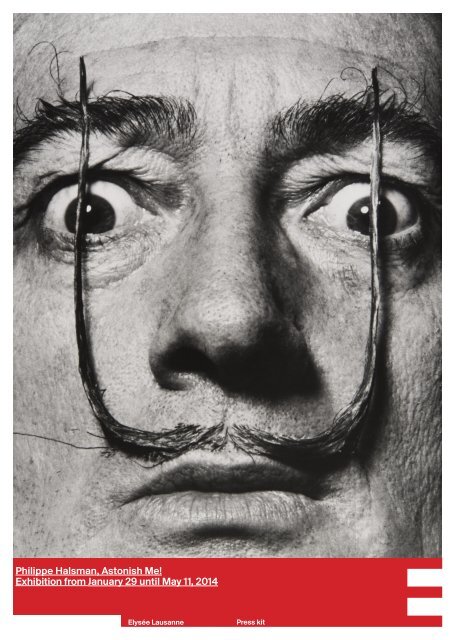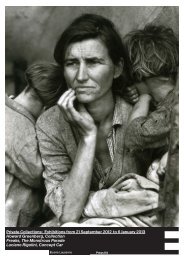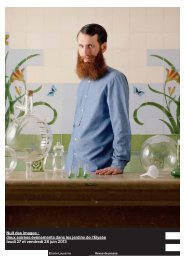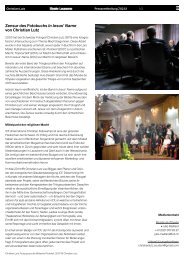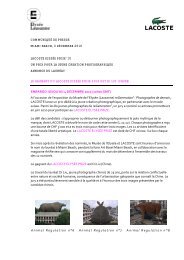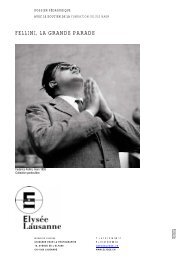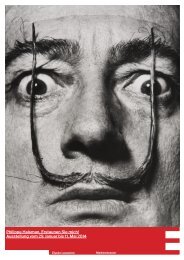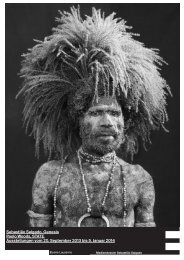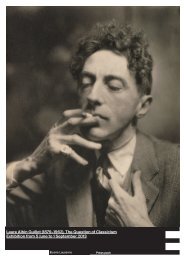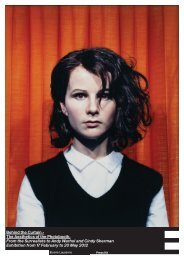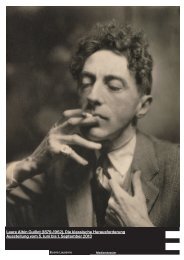Philippe Halsman, Astonish Me! Exhibition from ... - Musée de l'Elysée
Philippe Halsman, Astonish Me! Exhibition from ... - Musée de l'Elysée
Philippe Halsman, Astonish Me! Exhibition from ... - Musée de l'Elysée
You also want an ePaper? Increase the reach of your titles
YUMPU automatically turns print PDFs into web optimized ePapers that Google loves.
<strong>Philippe</strong> <strong>Halsman</strong>, <strong>Astonish</strong> <strong>Me</strong>!<strong>Exhibition</strong> <strong>from</strong> January 29 until May 11, 2014Elysée LausannePress kit
Upcoming exhibitions 11Press images 12<strong>Philippe</strong> <strong>Halsman</strong>Elysée LausannePress kit2/13PHILIPPEASTONISH ME!Presentation of the exhibition 3-7Biography of <strong>Philippe</strong> <strong>Halsman</strong> 8-9Related events 10The <strong>Musée</strong> <strong>de</strong> l’Elysée 13Practical information 13Press conferenceTuesday January 28, 2014 at 10am<strong>Exhibition</strong> OpeningTuesday January 28, 2014 at 6pmPress contactJulie Maillard+41 ( 0 ) 21 316 99 27julie.maillard@vd.chThe exhibition <strong>Philippe</strong> <strong>Halsman</strong>, <strong>Astonish</strong> me! was conceivedin collaboration with the <strong>Philippe</strong> <strong>Halsman</strong> Archive, and is ma<strong>de</strong>possible through support <strong>from</strong> the Terra Foundation for American Art,PKB Privatbank and Loterie Roman<strong>de</strong>.Cover: <strong>Philippe</strong> <strong>Halsman</strong>, Like Two Erect Sentries, My Mustache Defends the Entrance to My Real Self, Dalí’s Mustache, 1954<strong>Philippe</strong> <strong>Halsman</strong> Archive © 2013 <strong>Philippe</strong> <strong>Halsman</strong> Archive / Magnum PhotosExclusive rights for images of Salvador Dalí: Fundació Gala-Salvador Dalí, Figueres, 2014Above: <strong>Philippe</strong> <strong>Halsman</strong>, Self-portrait on tripod, 1950<strong>Philippe</strong> <strong>Halsman</strong> Archive © 2013 <strong>Philippe</strong> <strong>Halsman</strong> Archive / Magnum Photos
<strong>Philippe</strong> <strong>Halsman</strong>Elysée LausannePress kit3/13Presentation of the exhibitionIn 1921, <strong>Philippe</strong> <strong>Halsman</strong> found his father’s old camera, and spokeof a “miracle” when he <strong>de</strong>veloped his first glass plates in thefamily’s bathroom sink. He was 15 years old, and this was the firstencounter with photography of someone who was to become oneof the leading photographers of the 20 th century.This exhibition, produced by the <strong>Musée</strong> <strong>de</strong> l’Elysée in collaborationwith the <strong>Philippe</strong> <strong>Halsman</strong> Archive, showcases the Americanphotographer’s entire career for the first time, <strong>from</strong> his beginningsin Paris in the 1930s to the tremendous success of his New Yorkstudio between 1940 and 1970.<strong>Halsman</strong> was able to go to Paris thanks to the support of Frenchminister Paul Painlevé -whose son Jean, a scientific filmmaker,gave him one of the best cameras of the time upon his arrival.He remained in Paris for ten years, until 1940. Over that period, hecollaborated with the magazines Vogue, Vu and Voilà and createdportraits of numerous celebrities like Marc Chagall, Le Corbusierand André Malraux. He exhibited his work several times at theavant-gar<strong>de</strong> Pléia<strong>de</strong> gallery, alongsi<strong>de</strong> photographers like LaureAlbin Guillot, whose work was exhibited at <strong>Musée</strong> <strong>de</strong> l’Elysée in 2013.Fleeing Nazism, he left Paris in 1940 and moved to New York.There, he worked for many American magazines including Life,which brought him into contact with the century’s top celebrities—Marilyn Monroe, Rita Hayworth, Duke Ellington, the Duke andDuchess of Windsor, Richard Nixon, Albert Einstein to name only afew. <strong>Halsman</strong> shot 101 covers for Life magazine.Far <strong>from</strong> restricting himself to photographing celebrities, throughouthis whole life <strong>Halsman</strong> never stopped experimenting andpushing the limits of his medium. He collaborated with SalvadorDalí for over thirty years and invented 'jumpology', which consistedin photographing personalities in the middle of jumping, offering amore natural, spontaneous portrait of his sujets."Shortly before World War I, the greatest sensation inParis was the Russian Imperial Ballet un<strong>de</strong>r SergeDiaghilev. The divine Nijinsky and Pavlova were dancingfor him, Stravinsky composed, Picasso, Bakst, and Chagallwere painting scenery for him. To work for Diaghilevwas the highest accola<strong>de</strong> for an artist. Jean Cocteauapproached Diaghilev and asked: 'What can I do for you?'Diaghilev looked at him and answered: 'Etonne-moi!'('<strong>Astonish</strong> me!') These two words can be consi<strong>de</strong>redas a motto, as a slogan for the <strong>de</strong>velopment of themo<strong>de</strong>rn art which followed."<strong>Philippe</strong> <strong>Halsman</strong>This retrospective exhibition presents no less than 300 exclusiveimages and original documents, shedding new light on the work ofan exceptional, atypical photographer.This exhibition is produced by the <strong>Musée</strong> <strong>de</strong> l’Elysée, in collaborationwith the <strong>Philippe</strong> <strong>Halsman</strong> Archive. After Lausanne, it willbe presented at the Jeu <strong>de</strong> Paume in Paris (October 13, 2015 -February 14, 2016), at the Kunsthal Rotterdam (February 27 - June 5,2016), at the CaixaForum Barcelona (July 19 - October 30, 2016) andat the CaixaForum Madrid (November 29, 2016 - March 12, 2017).Curators• Sam Stourdzé, Director, <strong>Musée</strong> <strong>de</strong> l’Elysée, Lausanne• Anne Lacoste, Curator, <strong>Musée</strong> <strong>de</strong> l’Elysée, Lausanne<strong>Philippe</strong> <strong>Halsman</strong>, Portrait of Jean Cocteau with dancers Ricki Soma and Leo Coleman, 1949<strong>Musée</strong> <strong>de</strong> l’Elysée © 2013 <strong>Philippe</strong> <strong>Halsman</strong> Archive / Magnum Photos
<strong>Philippe</strong> <strong>Halsman</strong>Elysée LausannePress kit4/13The exhibition <strong>Philippe</strong> <strong>Halsman</strong>, <strong>Astonish</strong>me! is divi<strong>de</strong>d into four sections illustratingmemorable periods, collaborations and themesin the photographer’s work and life.Paris in the 1930s<strong>Philippe</strong> <strong>Halsman</strong> was born in Riga, Latvia in 1906. When he was22, his father died in a hiking acci<strong>de</strong>nt in Austrian Tyrol, and <strong>Philippe</strong><strong>Halsman</strong> was wrongly convicted of his mur<strong>de</strong>r in a highlyanti-Semitic climate. He was freed thanks to his sister’s support;she organized the support of prominent European intellectuals,who endorsed his innocence.He went to Paris, where he began his career as a photographer,quickly distinguishing himself through his portrait technique. Heexplored various genres, such as views of Paris, nu<strong>de</strong>s and fashion.His work was exhibited three times at the La Pléia<strong>de</strong> gallery, afamous avant-gar<strong>de</strong> gallery where artists like Man Ray, AndréKertész and Brassaï presented their works.Focus on La Pléia<strong>de</strong> galleryFoun<strong>de</strong>d by publisher Jacques Schiffrin in the spring of 1931 andlocated in the heart of the Latin Quarter, this art gallery was one ofthe first to present photographic exhibitions, and it started specializingin this field in April 1933 un<strong>de</strong>r directorship of Rose Sévèk.Dedicated to contemporary photography, the program incorporatedits new practices and applications. It was one of the places whereNew Photography was promoted in the form of solo, group orthematic exhibitions.It was probably through his friend Jean Painlevé that <strong>Halsman</strong>entered in contact with La Pléia<strong>de</strong> gallery. He was given a first soloexhibition, Portraits and Nu<strong>de</strong>s, which ran <strong>from</strong> March 28 to April30, 1936. The following year, his name became associated with theNew Vision movement in the context of two group exhibitions:Portraits of Writers (April 17 to May 14, 1937) which inclu<strong>de</strong>dEmmanuel Sougez, Rogi André, Roger Parry and others; La Parisienne<strong>de</strong> 1900… à 1937 (June 4-30, 1937), which inclu<strong>de</strong>d photographsby Florence Henri and Maurice Tabard. It was one of thelast exhibitions at the gallery, which was sold a few months later inOctober, to Paul Magné."In Goethe’s Faust, Dr. Faustus exclaims:‘Two souls – alas – live in my breast!‘ This remarkcertainly applies to me. In my serious work I am strivingfor the essence of things and for goals which arepossibly unreachable. On the other hand, everythinghumorous has great attraction for me, and a childishstreak leads me into all kinds of frivolous en<strong>de</strong>avor."<strong>Philippe</strong> <strong>Halsman</strong>Having initially been unable to flee wartime Paris, <strong>Halsman</strong> finallyreceived an emergency visa in 1940 thanks to a letter <strong>from</strong> AlbertEinstein to Eleanor Roosevelt, making it possible for him to join hisfamily, who had left six months earlier.<strong>Philippe</strong> <strong>Halsman</strong>, Poster for the exhibition Portraits and Nu<strong>de</strong>s at La Pléia<strong>de</strong> gallery, 1936<strong>Philippe</strong> <strong>Halsman</strong> Archive © 2013 <strong>Philippe</strong> <strong>Halsman</strong> Archive / Magnum Photos
<strong>Philippe</strong> <strong>Halsman</strong>Elysée LausannePress kit5/13PortraitsChampion of the direct approach, <strong>Philippe</strong> <strong>Halsman</strong> also experimentedwith a wi<strong>de</strong> range of techniques in or<strong>de</strong>r to capture theessence of his subjects and express their individuality. Many portraitsbecame iconic images such as his 101 Life magazine covers.Focus on Marilyn Monroe<strong>Philippe</strong> <strong>Halsman</strong> photographed Marilyn Monroe on severaloccasions between 1949 and 1959. This important corpus tracesthe actress’s career and reveals the photographer’s variedapproach during this period. In the autumn of 1949, <strong>Halsman</strong> wassent to Hollywood by Life magazine to do a report on eight youngmo<strong>de</strong>ls embarking on acting careers. <strong>Halsman</strong> photographed themin four scenes he imposed (the approach of a monster, embrassinga lover, reacting to a funny story and drinking a favorite drink). Hequickly noticed the talents of the young Marilyn Monroe.This opinion was confirmed three years later when Lifecommissioned him to do a feature on the actress entitled “TheTalk of Hollywood”. These shots, some in color and some in blackand white, illustrated the actresses’s everyday life and talents. Sheacted out a series of scenes, humorously presenting the differentstages of the strategy she used when being interviewed for roles.Most importantly, <strong>Halsman</strong> created several emblematic images ofthe actress and helped promote her by giving her a chance to haveher first Life magazine cover.In 1954, <strong>Halsman</strong> welcomed Marilyn Monroe to his New Yorkstudio. <strong>Halsman</strong>’s photographs reflect the 'sex symbol' image shecultivated. However, he managed to shoot a more natural portraitof the actress by asking her to jump in the air. There was only a fewimages of this type because when <strong>Halsman</strong> explained his'jumpology' concept, Marilyn Monroe, frightened by the i<strong>de</strong>a ofrevealing her personality, refused to repeat the experiment.It took five years before she agreed to go along with 'jumpology'.Marilyn Monroe had become a star by the time Life magazineoffered to feature her on its cover in 1959 to illustrate a major articleon <strong>Philippe</strong> <strong>Halsman</strong>’s 'jumpology'. She treated it as a request for aperformance. Over the course of three hours, the actress jumpedover 200 times in front of <strong>Halsman</strong>’s lens, in or<strong>de</strong>r to achieve the“perfect jump”."Of the group of starlets only Marilyn emerged.Still photographers discovered her natural talent forflirting with the camera lens, and her blondlooks of instant availability ma<strong>de</strong> herAmerica’s most popular pin-up girl.Marilyn felt that the lens was not just a glass eye, butthe symbol of the eyes of millions of men.She knew how to woo this lens betterthan any actress I ever photographed."<strong>Philippe</strong> <strong>Halsman</strong>Several times <strong>Halsman</strong> suggested to Marilyn Monroe that theycontinue this collaboration, but without success. The actresswas then at a turning point in her life that was foreshadowing her<strong>de</strong>cline. However, <strong>Halsman</strong> continued his photographic work onthe actress by creating new images, or more precisely variations ofportraits he had previously shot. These compositions -montagesof prints cut out and rephotographed together expressing the i<strong>de</strong>aof movement, or reworked images transposed in negative formarecharacteristic of <strong>Halsman</strong>’s approach in the 1960s. Ten yearslater, he created a portrait of Marilyn Monroe as Chairman Mao,as requested by Salvador Dalí during his guest editorship of theFrench edition of Vogue magazine (December 1971-January 1972).<strong>Philippe</strong> <strong>Halsman</strong>, Contact print of Marilyn Monroe, 1952<strong>Philippe</strong> <strong>Halsman</strong> Archive © 2013 <strong>Philippe</strong> <strong>Halsman</strong> Archive / Magnum Photos
<strong>Philippe</strong> <strong>Halsman</strong>Elysée LausannePress kit6/13Mises en scène<strong>Halsman</strong> was often commissioned to photograph the contemporaryart scene for magazines including dance, cinema and theatre.Collaborations with artists were important in <strong>Halsman</strong>’s career andinspired performances resulting in picture stories or striking individualimages.Focus on 'Jumpology'In 1950, <strong>Halsman</strong> invented 'jumpology', a new way of creatingspontaneous, authentic portraits: “When you ask a person to jump,his attention is mostly directed toward the act of jumping andthe mask falls so that the real person appears”. Over a period often years, <strong>Halsman</strong> created an extraordinary gallery of portraits ofAmerican society.Containing over 170 portraits, <strong>Philippe</strong> <strong>Halsman</strong>'s Jump Bookillustrated a new “psychological portrait” approach <strong>de</strong>veloped by<strong>Philippe</strong> <strong>Halsman</strong> in the 1950s. His method was systematic. Duringcommissioned work, at the end of shooting sessions <strong>Halsman</strong>would ask his subjects if they would agree to take part in hispersonal project, and then the jumps were done on the spot. Inthis way he managed to photograph hundreds of jumps. Producingthese shots was in fact simple: his equipment was limited to aRolleiflex camera and an electronic flash, and as he pointed out, theonly constraint was the height of the ceiling.Although these portraits are characterized by their lightheartedness,<strong>Halsman</strong> viewed 'jumpology' as a new scientific toolfor psychology. While the subject was concentrating on his jump,“the mask” fell, and it was this moment that the photographernee<strong>de</strong>d to capture. Over the time that he was conducting thisexperiment, <strong>Halsman</strong> noticed the great diversity of the variousparticipants’ postures, and discerned in these gestures -legpositions, arm positions, facial expressions and other <strong>de</strong>tailsrevealingsigns of their character, expressed unwillingly.The arrangement of the portraits in <strong>Philippe</strong> <strong>Halsman</strong>'s Jump Bookillustrated these views. <strong>Halsman</strong> ma<strong>de</strong> a distinction in the form oftwo corpuses. First he presented influential personalities <strong>from</strong> differentfields (political, industrial, scientific, theological, literary, etc…)resulting in a gallery of unexpected portraits that contrasted withtheir official image. For this project, <strong>Halsman</strong> also enjoyed the collaborationof actors, singers, dancers, etc… Conscious of the specialcharacter of their performances, <strong>Halsman</strong> assembled their imagesin a second part, categorized by discipline. This organization waspunctuated by various themes like American flamboyance,British reserve, and the eloquence of actresses’ legwork. The layoutplayed with different photograph formats and assemblages."I have photographed Richard Nixon four timesand each time I faced a different man. In 1955when he was Vice-Presi<strong>de</strong>nt I photographed himfor the cover of Collier's. (...) The Vice-Presi<strong>de</strong>ntwas not very loquacious and seemed to be alwayson his guard. At that period of my career I used to askevery one of my sitters to jump for me. I was ready fora stuffy refusal <strong>from</strong> Mr. Nixon but he obliged witha rather non-committal jump."<strong>Philippe</strong> <strong>Halsman</strong>Although it only presented well-known personalities, the publicationnevertheless encouraged the <strong>de</strong>mocratization of this practice:it en<strong>de</strong>d with a photograph of <strong>Philippe</strong> <strong>Halsman</strong> jumping on abeach, with a caption asking: “How do you jump?”<strong>Philippe</strong> <strong>Halsman</strong>, Richard Nixon, 1955<strong>Philippe</strong> <strong>Halsman</strong> Archive © 2013 <strong>Philippe</strong> <strong>Halsman</strong> Archive / Magnum Photos
<strong>Philippe</strong> <strong>Halsman</strong>Elysée LausannePress kit7/13<strong>Halsman</strong>/DalíOne of <strong>Halsman</strong>’s favourite subjects was Salvador Dalí with whomhe shared a unique collaboration that spanned 37 years. Their 47sittings, combining Dalí’s talent for performance and <strong>Halsman</strong>’stechnical skill and inventiveness, resulting in an impressive repertoireof “photographic i<strong>de</strong>as”.Focus on Dalí’s MustacheAs <strong>Halsman</strong> explains, Dalí’s Mustache is the fruit of this marriageof the minds. They conceived this book entirely <strong>de</strong>dicated to Dalí’smustache, and created over thirty portraits of the painter absurdlyanswering <strong>Halsman</strong>’s questions.In 1953 <strong>Halsman</strong> realised that Salvador Dalí’s expanding mustachegave him the "chance to fulfil one his most ambitious dreams yetand create an extraordinarily eccentric work". Dalí was enormouslyfond of his own person and of his mustache in particular, which hesaw as a symbol of the power of his imagination, and wasimmediately thrilled at the i<strong>de</strong>a. To create a “photo-interview book”containing an interview with Salvador Dalí, <strong>Halsman</strong> reused aneditorial concept he had introduced five years earlier with Frenchactor Fernan<strong>de</strong>l: a question asked of the artist was printed on onepage, and the answer appeared on the following page in the form ofa captioned photograph.For this project, it was no longer just a matter of photographicexpression, but of genuine mise en scène, combining Dalí’stheatrical character with <strong>Halsman</strong>’s impressive inventiveness andtechnical skill. <strong>Halsman</strong> presented the book as a genuinecollaboration between two artists, representing theirmutual un<strong>de</strong>rstanding.<strong>Halsman</strong> photographed Dalí with his 4x5 camera and his electronicflash through many sessions over a period of two years. Most ofthe plates in the book are portraits of the artist posing in a variety ofpositions, playing with his mustache in various ways, accentuatedby light and framing effects. Dalí was ready to go along with anywhim to create the scenes: he styles his precious mustache withthe help of Hungarian wax, and agrees to take part in incongruousmises en scène, pressing his head behind a round of cheese to putthe ends of his mustache through its holes, or plunging his headinto a water-filled aquarium, his mouth full of milk."In the thirty years of our friendship I have ma<strong>de</strong>countless photographs showing the surrealist painterin the most incredible situations. Whenever I nee<strong>de</strong>da striking or famous protagonist for one of my wild i<strong>de</strong>as,Dalí would graciously oblige. Whenever Dalí thoughtof a photograph so strange that it seemedimpossible to produce, I tried to find a solution.'Can you make me look like Mona Lisa?...Can you make a man one half of whom would look likeDalí and the other half like Picasso?' I could and I did."<strong>Philippe</strong> <strong>Halsman</strong>As for <strong>Halsman</strong>, he put a lot of his effort into the post-productionwork in or<strong>de</strong>r to give concrete expression to their i<strong>de</strong>as. Itsometimes took a laborious process to achieve images like theMona Lisa portrait, inner conflicts, surrealism or the essence of Dalí,which not only required work on the print or negative (cutting,enlargement, <strong>de</strong>formation, double exposure) but also a montageand a new shot to create a negative of the final image. For theportrait of the artist in the form of a “soft watch”, <strong>Halsman</strong> workedaround one hundred hours. He photographed Dali close up, thentacked a wet print of the image onto the edge of a table and rephotographedit at an angle that matched the angle of the originalpainting. He then cut it out, ma<strong>de</strong> a collage, and re-photographedit again - creating an image of Dali's melted face. For thephotographer, it was a genuine technical challenge, which heseized with patience and success.<strong>Philippe</strong> <strong>Halsman</strong>, Salvador Dalí performing for the “Morning Show” on CBS-TV, 1956<strong>Philippe</strong> <strong>Halsman</strong> Archive © 2013 <strong>Philippe</strong> <strong>Halsman</strong> Archive / Magnum PhotosExclusive rights for images of Salvador Dalí: Fundació Gala-Salvador Dalí, Figueres, 2014
<strong>Philippe</strong> <strong>Halsman</strong>Elysée LausannePress kit8/13Biography of <strong>Philippe</strong> <strong>Halsman</strong>1906 May 2: <strong>Philippe</strong> <strong>Halsman</strong> is born Filips <strong>Halsman</strong>n, at Riga,Latvia, the son of Max (Morduch) <strong>Halsman</strong>, a <strong>de</strong>ntist, andIta Grintuch, head of a primary school.1921 <strong>Halsman</strong> discovers his father’s old camera and beginsphotographing his family and friends. He talks in terms ofa ‘miracle’ happening as he <strong>de</strong>velops the glass plates inthe bathroom sink.1928 September 10: <strong>Halsman</strong>’s father dies acci<strong>de</strong>ntally whileon a hiking trip in the Austrian Tyrol. Anti-semitism is rife inthe country and <strong>Philippe</strong> <strong>Halsman</strong>, who accompanied hisfather, is falsely accused of his mur<strong>de</strong>r. He is sentencedto ten years in solitary confinement. His sister Lioubalaunched a campaign for his release, which was supportedby leading European intellectuals like Albert Einstein,Thomas Mann and Sigmund Freud.1931 January 26: <strong>Halsman</strong> arrives in Paris after gaining asylumthanks to the intervention of the French ministerPaul Painlevé. Painlevé’s son Jean also plays an importantpart in helping <strong>Halsman</strong> at the start of his career in France:he provi<strong>de</strong>s him with the best camera available at the time(a Kodak 9 x 12), and introduces him to the Paris scene.They become firm friends as is manifest in the richand lengthy correspon<strong>de</strong>nce which they maintain until<strong>Halsman</strong>’s <strong>de</strong>ath.1931- <strong>Halsman</strong>’s work appears in Vogue, Vu and Voilà magazines.1940 He produces portraits of many artists, including AndreGi<strong>de</strong>, Paul Valery, Andre Malraux, Jean Painleve, MarcChagall, Clau<strong>de</strong> Simon, Jean Giraudoux and Le Corbusier.1936 With his Rolleiflex, <strong>Halsman</strong> travels to Palestine to coverwhat will be his only international news report international.He also travels to Damascus, Jerusalem and Tel Aviv.1937 April 1: <strong>Halsman</strong> marries Yvonne Moser, by nowestablished as a photographer in her own right, withwhom he will work all his life.1940 His wife, his daughter, Irene, his mother, his sister and hisnieces leave Bor<strong>de</strong>aux for the United States on a freighter.Because he holds a Latvian passport and the quota ofvisas issued to Latvian nationals has already been reached,<strong>Halsman</strong> is unable to leave France. Six months later, hereceives an emergency visa thanks to the intervention ofAlbert Einstein and Eleanor Roosevelt.1941 April: <strong>Halsman</strong> meets Salvador Dalí in New York. This marksthe start of their collaboration which continues until 1978.1942 October 5: <strong>Halsman</strong> produces his first cover picture forLife magazine, a fashion photograph called ‘Eye-Catcher’.1943 <strong>Halsman</strong> produces a portrait of the Republican presi<strong>de</strong>ntialcandidate Wen<strong>de</strong>ll Willkie for the cover of his book OneWorld. <strong>Halsman</strong> ‘invents’ the i<strong>de</strong>a of the photographiccredit, insisting that his name be inclu<strong>de</strong>d on the cover.1944 <strong>Halsman</strong> gets his first commissions <strong>from</strong> Life to go toCalifornia where he photographs Hollywood stars includingHumphrey Bogart, Lauren Bacall, Frank Sinatra, IngridBergman, Bette Davis and Judy Garland."When I arrived in America in 1940 I had to adapt to theAmerican style, that is to say, produce photographs thatwere technically perfect, clear, precise and properlymo<strong>de</strong>lled by the light without being distorted.Once, to accentuate the coldness of a rainy landscapeI ad<strong>de</strong>d a blue gelatin to my transparent film. WilsonHicks took this gelatin off saying: 'You're cheating,<strong>Philippe</strong>'. Any hint of artifice was consi<strong>de</strong>red dishonest."<strong>Philippe</strong> <strong>Halsman</strong><strong>Philippe</strong> <strong>Halsman</strong>, Family portrait with -<strong>from</strong> left to right- Jane, Yvonne, <strong>Philippe</strong> and Irene <strong>Halsman</strong>, 1948<strong>Philippe</strong> <strong>Halsman</strong> Archive © 2013 <strong>Philippe</strong> <strong>Halsman</strong> Archive / Magnum Photos
<strong>Philippe</strong> <strong>Halsman</strong>Elysée LausannePress kit9/131947 <strong>Halsman</strong> produces his iconic portrait of Albert Einstein atPrinceton University. The photograph was used on thecover of Time magazine's "Person of the Century" issuein 1999.1948 <strong>Halsman</strong> and Dalí produce their photograph ofDalí Atomicus, which takes 26 attempts and more than fivehours to set up.1949 <strong>Halsman</strong> meets Marilyn Monroe. Sent to Hollywood byLife magazine to cover a story about eight young mo<strong>de</strong>lswho are setting out on careers as actresses. He quicklyrecognises her talents and singles her out <strong>from</strong> theother starlets.1951 <strong>Halsman</strong> returns to Europe for the first time since 1940.Among others, he photographs Winston Churchill, HenriMatisse, Jean-Paul Sartre, Brigitte Bardot. PhotographingChagall at Vallauris, he meets Pablo Picasso.1954 <strong>Halsman</strong> photographs Marilyn Monroe in his studioin New York. He mostly concentrates on the actress’smanufactured, ‘sex-symbol’ image, but he also managesto capture a rather more natural portrait of her, performingher first jump. She will refuse to repeat the experimentuntil 1959.1958 He takes part in the exhibition called Photographs Fromthe Museum Collection put on by Edward Steichen at theMuseum of Mo<strong>de</strong>rn Art (MoMA) in New York.1959 <strong>Philippe</strong> <strong>Halsman</strong>'s Jump Book is published by Simon &Schuster. It inclu<strong>de</strong>s over a hundred and seventy picturesof famous people jumping.1961 <strong>Halsman</strong> photographs numerous leading figures:Presi<strong>de</strong>nt John F. Kennedy and his cabinet at the WhiteHouse for Look magazine, the dancer Edward Villela forthe Saturday Evening Post, Robert F. Kennedy, MickeyMantle, the playwright Edward Albee and the actress andsinger Anna Maria Alberghetti for Life, as well as EleanorRoosevelt and the photographer Weegee.1962 <strong>Halsman</strong> goes to Hollywood to take promotionalphotographs of Alfred Hitchcock’s feature film The Birds.They appear on the cover of Life magazine and in Look.1963 The first major exhibition <strong>de</strong>voted to the photographer,<strong>Philippe</strong> <strong>Halsman</strong>, is held at the Smithsonian PhotographyGallery in Washington.1965 His portrait of Churchill is used on a United States postagestamp to commemorate the statesman who dies this year.1966 <strong>Halsman</strong> goes to Montreux to photograph VladimirNabokov. It is the first of several long sessions he hasphotographing the Russian writer.1969 <strong>Halsman</strong> produces an official portrait of Presi<strong>de</strong>nt RichardNixon. He takes pictures for Life of Woody Allen and MaeWest. He also photographs Stalin’s daughter,Svetlana Aliluyeva.1970 January 23: his hundredth cover picture for Life appears,featuring the American compere and comedianJohnny Carson.1971 <strong>Halsman</strong> refers to his <strong>de</strong>clining state of health in a letter toPainlevé in February.1979 A major <strong>Halsman</strong> retrospective exhibit opens at theInternational Center of Photography in New York.June 25: <strong>Philippe</strong> <strong>Halsman</strong> dies in New York."(100 covers, it is) like winning 100 contestsagainst tremendous competition each time.I must have shot some 300 subjects for covers.I guess one out of three is a pretty goodbatting average in my tough league, but therewere some that were heartbreaks."<strong>Philippe</strong> <strong>Halsman</strong>Cover of the magazine Life with a portrait of Marilyn Monroe by <strong>Philippe</strong> <strong>Halsman</strong>, November 9, 1959<strong>Musée</strong> <strong>de</strong> l’Elysée © 2013 <strong>Philippe</strong> <strong>Halsman</strong> Archive / Magnum Photos
<strong>Philippe</strong> <strong>Halsman</strong>Elysée LausannePress kit10/13Related events• <strong>Exhibition</strong> catalogueTwo catalogues are being published on the occasion of theexhibition: a French version by Editions Photosynthèses(<strong>Philippe</strong> <strong>Halsman</strong>, Etonnez-moi !) and an English version byPrestel Publishing (<strong>Philippe</strong> <strong>Halsman</strong>, <strong>Astonish</strong> <strong>Me</strong>!).This 320-page publication presents the very first study of<strong>Philippe</strong> <strong>Halsman</strong>'s complete body of work. The book inclu<strong>de</strong>s twoessays: one on his creative process, by Anne Lacoste, curator ofthe exhibition, and another on his collaboration with Salvador Dalí,by Marc Aufraise. Completing the study are a text by the <strong>Halsman</strong>family <strong>de</strong>scribing their most personal memories of the photographerand a <strong>de</strong>tailed chronology.The book, divi<strong>de</strong>d into four sections (“Paris in the 1930s", "Portraits",“Mises en scène", “<strong>Halsman</strong>/Dalí") is richly illustrated with over 250reproductions (original silver proofs, color prints, mock-ups, photomontages,preliminary proofs).• ConferencesIn or<strong>de</strong>r to take a closer look at <strong>Philippe</strong> <strong>Halsman</strong>, his life and hiswork, several conferences are being organized:Iconic Portraits and Behind the Scenes with Salvador Dalíby Irene <strong>Halsman</strong>, daughter of the photographer and co-director ofthe <strong>Philippe</strong> <strong>Halsman</strong> ArchiveWednesday, January 29, 2014, 6:30pmSalvador Dalí and <strong>Philippe</strong> <strong>Halsman</strong>: Advertising Geniusesby Marc Aufraise, PhD in art history, specialising in Salvador Dalíand photographyThursday, March 20, 2014, 6:30pmConference by researchers of the NCCR Affective Sciencesof the University of GenevaWednesday, April 30, 2014, 6:30pmThe conferences take place in the Salle Lumière at the <strong>Musée</strong> <strong>de</strong>l’Elysée. Register on www.elysee.ch.• Cultural ProgramGui<strong>de</strong>d ToursSundays February 2 and 23, March 16, April 13, May 11, 4pmWith a museum gui<strong>de</strong>. Inclu<strong>de</strong>d in the admission fee.Family program at the MuseumSundays February 2 and 23, March 16, April 13, May 11, 4pmWhile parents visit the exhibition, kids are invited to discoverit through playful activities. Free of charge, for children aged 6 to 12.Workshop for Children: PâKOMUZé“Jeux d’image – A playful introduction to the image in photography”April 15-17, 2-5 pmLed by recently graduated photographers, these photographyworkshops scheduled during the Easter holidays are for childrenaged 6 to 12. Fee: CHF 10.– Registration on www.elysee.ch• <strong>Astonish</strong> us on social networks!Express your creativity in the style of <strong>Philippe</strong> <strong>Halsman</strong> and shareyour impressions on social networks! A 'jumpology' studio is at yourdisposal in the Salle Lumière during the entire exhibition.Cover of the book <strong>Philippe</strong> <strong>Halsman</strong>, Etonnez-moi ! © Editions Photosynthèses / <strong>Musée</strong> <strong>de</strong> l’Elysée
<strong>Philippe</strong> <strong>Halsman</strong>Elysée LausannePress kit11/13Upcoming exhibitions 2014At the <strong>Musée</strong> <strong>de</strong> l’ElyséeFrom June 4 until August 24, 2014: Luc Chessex, Cuba andMatthieu Gafsou, Only God Can Judge <strong>Me</strong>The exhibition of photographer Luc Chessex mainly focuses onthree conceptual series he produced in Cuba in the 1960s and1970s: Che Guevara, Le Visage <strong>de</strong> la Révolution / The Face of theRevolution (Fi<strong>de</strong>l Castro) and Coca-Cola. At the same time, the<strong>Musée</strong> <strong>de</strong> l’Elysée is producing and presenting for the first timethe new series by photographer Matthieu Gafsou focusing on theLausanne drug scene. His project takes a different approach to thistopical, trivialised subject, in the form of a poetic, dreamlike ballad.Saturday June 28, 2014: Nuit <strong>de</strong>s imagesThe Nuit <strong>de</strong>s images returns the last weekend of June. With aunique program of screenings, concerts and various activities, theevent held in the gar<strong>de</strong>ns of the museum aims at providing thepublic with a welcoming and festive event.From September 17 until January 4, 2015: Amos GitaïThis first retrospective of the work of Israeli filmmaker Amos Gitaï isco-produced with the Swiss Film Archive, the Cinemathèque françaiseand Galeries, Brussels. This multimedia project (documents,films and photographs selected <strong>from</strong> the filmmaker’s archives)presents the artist’s favorite themes: boundaries, architecture, historyand mythology, etc… Simultaneously, two exhibitions explorethe filmmaker’s relationship with photography: the first, Army Days,gathers photographic works by Amos Gitaï produced in the 1960sand 1970s, while the other presents his collaboration with Italianphotographer Gabriele Basilico based on the itinerary of his filmFree Zone produced in 2004.Traveling exhibitionsThe <strong>Musée</strong> <strong>de</strong> l’Elysée preserves, promotes and exhibits a consi<strong>de</strong>rablephotographic heritage within its walls in Lausanne. Throughits external affairs activities, it nurtures collaborations with institutionsaround the world and gives wi<strong>de</strong> exposure to this heritage.In 2013, the museum's exhibitions traveled to Japan, the UnitedStates, Nigeria, Madagascar, France and Russia.At the beginning of this year, the exhibition Gilles Caron, theConflict Within starts its international tour with a first stop at theMuseum of Photography in Charleroi, Belgium. At the same time,the Jean Mohr exhibition, produced in collaboration with PresenceSwitzerland, continues its world tour in Europe, Africa and Asia.Gilles Caron, le conflit intérieur<strong>Musée</strong> <strong>de</strong> la Photographie, Charleroi, BelgiqueFrom January 25 until May 18, 2014War <strong>from</strong> the Victim's Perspective – Photographs by Jean MohrFollow the international tour on www.elysee.ch/itinerantes/carte/Matthieu Gafsou, Coke, 2012 © Matthieu Gafsou / Courtesy Galerie CGilles Caron, After a confrontation between Catholic <strong>de</strong>monstrators and police of Ulster, August 1969 © Fondation Gilles Caron
<strong>Philippe</strong> <strong>Halsman</strong>Elysée LausanneDossier Press kit<strong>de</strong> presse12/12 12/13The following images are available for the pressThe reproduction of the images below is authorized within the soleframework of the promotion of the exhibition and during its duration.The images must not be reframed and the caption must be used.For full page use, please contact us.To download the images:ftp://84.16.80.83/web/press/<strong>Halsman</strong>_firstuser : presspassword: 1006_mel_14<strong>Philippe</strong> <strong>Halsman</strong>, Poster for the exhibition Portraits and Nu<strong>de</strong>s at La Pléia<strong>de</strong> gallery<strong>Philippe</strong> <strong>Halsman</strong> Archive © 2013 <strong>Philippe</strong> <strong>Halsman</strong> Archive / Magnum Photos<strong>Philippe</strong> <strong>Halsman</strong>, The Versatile Jean Cocteau, 1949<strong>Philippe</strong> <strong>Halsman</strong> Archive © 2013 <strong>Philippe</strong> <strong>Halsman</strong> Archive / Magnum Photos<strong>Philippe</strong> <strong>Halsman</strong>, Alfred Hitchcock for the promotion of the film The Birds, 1962<strong>Musée</strong> <strong>de</strong> l’Elysée © 2013 <strong>Philippe</strong> <strong>Halsman</strong> Archive / Magnum Photos<strong>Philippe</strong> <strong>Halsman</strong>, Marilyn Monroe,1959. <strong>Musée</strong> <strong>de</strong> l’Elysée © 2013<strong>Philippe</strong> <strong>Halsman</strong> Archive / MagnumPhotosCover of the magazine Life with aportrait of Marilyn Monroe jumping by<strong>Philippe</strong> <strong>Halsman</strong>, November 9, 1959<strong>Musée</strong> <strong>de</strong> l’Elysée © 2013 <strong>Philippe</strong><strong>Halsman</strong> Archive / Magnum Photos<strong>Philippe</strong> <strong>Halsman</strong>, Dalí Atomicus, 1948<strong>Musée</strong> <strong>de</strong> l’Elysée © 2013 <strong>Philippe</strong> <strong>Halsman</strong> Archive / Magnum PhotosExclusive rights for images of Salvador Dalí: Fundació Gala-Salvador Dalí,Figueres, 2014<strong>Philippe</strong> <strong>Halsman</strong>, Like Two Erect Sentries, My Mustache Defends the Entrance toMy Real Self, Dalí’s Mustache, 1954<strong>Philippe</strong> <strong>Halsman</strong> Archive © 2013 <strong>Philippe</strong> <strong>Halsman</strong> Archive / Magnum PhotosExclusive rights for images of Salvador Dalí: Fundació Gala-Salvador Dalí, Figueres, 2014
<strong>Philippe</strong> <strong>Halsman</strong>Elysée LausannePress kit13/13The <strong>Musée</strong> <strong>de</strong> l’ElyséeMissionThe <strong>Musée</strong> <strong>de</strong> l’Elysée is one of the world’s leading museumsentirely <strong>de</strong>dicated to photography. Since its establishment in 1985,it has improved public un<strong>de</strong>rstanding of photography throughinnovative exhibitions, key publications and engaging events.Recognized as a centre of expertise in the field of conservationand enhancement of visual heritage, it holds a unique collectionof more than 100,000 prints and preserves several photographicalarchives, in particular those of Ella Maillart, Nicolas Bouvier, CharlieChaplin and René Burri. By supporting young photographers,offering new perspectives on the masters and confrontingphotography with other art forms, the <strong>Musée</strong> <strong>de</strong> l’Elysée experimentswith the image.Based in Switzerland, it presents four major exhibitions in Lausanneeach year and an average of fifteen in prestigious museums andfestivals around the world. Regional by character and internationalin scope, it seeks to constantly <strong>de</strong>velop new and exciting waysto interact with audiences and collaborate with other institutions.Practical informationAddress of the <strong>Musée</strong> <strong>de</strong> l’Elysée18, avenue <strong>de</strong> l’ElyséeCH - 1014 LausanneT + 41 21 316 99 11F + 41 21 316 99 12www.elysee.chThe museum has a Facebook, a Twitter page and an Instagram.@ElyseeMusee #<strong>Halsman</strong>Elysee#Jump #<strong>Astonish</strong><strong>Me</strong> #<strong>Philippe</strong><strong>Halsman</strong> #ITweetMuseumsOpening HoursTuesday - Sunday, 11am - 6pmClosed Monday, except for bank holidaysAdmission FeeAdults CHF 8.00AVS CHF 6.00Stu<strong>de</strong>nts / Apprentices / AC / AI CHF 4.00Free entry for those un<strong>de</strong>r 16Free entry on the first Saturday of the monthView of the <strong>Musée</strong> <strong>de</strong> l’Elysée © Yves AndréView of the bookstore of the <strong>Musée</strong> <strong>de</strong> l’Elysée


